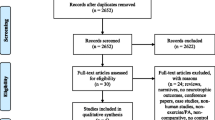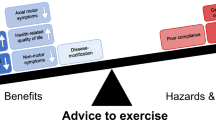Abstract
Introduction
Endogenous brain-derived neurotrophic factor (BDNF) is thought to be protective against the neurodegeneration seen in Parkinson’s disease (PD), and is thought to increase during exercise. This has been proposed as a possible mechanism by which exercise improves outcomes for people with PD. We conducted a pilot study to investigate the role of exercise intensity on BDNF levels in people with PD.
Methods
Participants of early- to mid-stage disease were recruited from a single PD service in north-east England, UK into two separate studies of exercise in PD, one involving moderate-intensity continuous training (MICT) and one involving high-intensity interval training (HIIT), both had control groups. In both the interventions, participants exercise three times per week for 12 weeks. Blood samples were taken for BDNF analysis at the start and end of the first session and the start and end of the final session, with corresponding samples taken in controls.
Results
Data were available for 27 participants (13 intervention, 14 control) in the MICT intervention and 17 (9 intervention, 8 control) in the HIIT intervention. BDNF level did not rise significantly from the start to end of individual sessions. Across the 12 week period, they rose significantly in the HIIT intervention group, but not in controls or the MICT intervention group.
Conclusions
High-intensity interval training appears to have a greater impact on BDNF than MICT. Future work should directly compare exercise modalities and investigate the impact of BDNF levels on disease progression and quality of life.


Similar content being viewed by others
Data availability
The datasets generated during and analysed during the current study are available from the corresponding author on reasonable request.
References
Sampaio TB, Savall AS, Gutierrez MEZ et al (2017) Neurotrophic factors in Alzheimer’s and Parkinson’s diseases: implications for pathogenesis and therapy. Neural Regen Res 12:549–557
Erickson KI, Prakash RS, Voss MW et al (2010) Brain-derived neurotrophic factor is associated with age-related decline in hippocampal volume. J Neurosci 30:5368–5375
Lommatzsch M, Zingler D, Schuhbaeck K et al (2005) The impact of age, weight and gender on BDNF levels in human platelets and plasma. Neurobiol Aging 26:115–123
Parain K, Murer MG, Yan Q et al (1999) Reduced expression of brain-derived neurotrophic factor protein in Parkinson’s disease substantia nigra. NeuroReport 10:557–561
Howells DW, Porritt MJ, Wong JY et al (2000) Reduced BDNF mRNA expression in the Parkinson’s disease substantia nigra. Exp Neurol 166:127–135
Murer MG, Yan Q, Raisman-Vozari R (2001) Brain-derived neurotrophic factor in the control human brain, and in Alzheimer’s disease and Parkinson’s disease. Prog Neurobiol 63:71–124
Hyman C, Hofer M, Barde YA et al (1991) BDNF is a neurotrophic factor for dopaminergic neurons of the substantia nigra. Nature 350:230–232
Lu B, Nagappan G, Guan X et al (2013) BDNF-based synaptic repair as a disease-modifying strategy for neurodegenerative diseases. Nat Rev Neurosci 14:401–416
Jimenez-Maldonado A, Renteria I, Garcia-Suarez PC et al (2018) The impact of high-intensity interval training on brain derived neurotrophic factor in brain: a mini-review. Front Neurosci 12:839
Schmolesky MT, Webb DL, Hansen RA (2013) The effects of aerobic exercise intensity and duration on levels of brain-derived neurotrophic factor in healthy men. J Sports Sci Med 12:502–511
da Silva PG, Domingues DD, de Carvalho LA et al (2016) Neurotrophic factors in Parkinson’s disease are regulated by exercise: evidence-based practice. J Neurol Sci 363:5–15
Fumagalli F, Racagni G, Riva MA (2006) Shedding light into the role of BDNF in the pharmacotherapy of Parkinson’s disease. Pharmacogenom J 6:95–104
Ahlskog JE (2011) Pathological behaviors provoked by dopamine agonist therapy of Parkinson’s disease. Physiol Behav 104:168–172
Goodwin VA, Richards SH, Taylor RS et al (2008) The effectiveness of exercise interventions for people with Parkinson’s disease: a systematic review and meta-analysis. Mov Disord 23:631–640
Gibala MJ, Little JP, Macdonald MJ et al (2012) Physiological adaptations to low-volume, high-intensity interval training in health and disease. J Physiol 590:1077–1084
Schenkman M, Moore CG, Kohrt WM et al (2018) Effect of high-intensity treadmill exercise on motor symptoms in patients with de novo parkinson disease: a phase 2 randomized clinical trial. JAMA Neurol 75:219–226
Wisloff U, Stoylen A, Loennechen JP et al (2007) Superior cardiovascular effect of aerobic interval training versus moderate continuous training in heart failure patients: a randomized study. Circulation 115:3086–3094
Harvey M, Weston KL, Gray WK et al (2019) High-intensity interval training in people with Parkinson’s disease: a randomized, controlled feasibility trial. Clin Rehabil 33:428–438
Hurst C, Weston KL, Weston M (2019) The effect of 12 weeks of combined upper- and lower-body high-intensity interval training on muscular and cardiorespiratory fitness in older adults. Aging Clin Exp Res 31:661–671
Ellis T, Boudreau JK, DeAngelis TR et al (2013) Barriers to exercise in people with Parkinson disease. Phys Ther 93:628–636
Nasreddine ZS, Phillips NA, Bedirian V et al (2005) The Montreal Cognitive Assessment, MoCA: a brief screening tool for mild cognitive impairment. J Am Geriatr Soc 53:695–699
Coelho FG, Gobbi S, Andreatto CA et al (2013) Physical exercise modulates peripheral levels of brain-derived neurotrophic factor (BDNF): a systematic review of experimental studies in the elderly. Arch Gerontol Geriatr 56:10–15
Ahlskog JE (2011) Does vigorous exercise have a neuroprotective effect in Parkinson disease? Neurology 77:288–294
Coetsee C, Terblanche E (2017) Cerebral oxygenation during cortical activation: the differential influence of three exercise training modalities. A randomized controlled trial. Eur J Appl Physiol 117:1617–1627
Robinson MM, Lowe VJ, Nair KS (2018) Increased brain glucose uptake after 12 weeks of aerobic high-intensity interval training in young and older adults. J Clin Endocrinol Metab 103:221–227
Saucedo Marquez CM, Vanaudenaerde B, Troosters T et al (2015) High-intensity interval training evokes larger serum BDNF levels compared with intense continuous exercise. J Appl Physiol 119:1363–1373
Cabral-Santos C, Castrillon CI, Miranda RA et al (2016) Inflammatory cytokines and BDNF response to high-intensity intermittent exercise: effect the exercise volume. Front Physiol 7:509
Enette L, Vogel T, Fanon JL et al (2017) Effect of interval and continuous aerobic training on basal serum and plasma brain-derived neurotrophic factor values in seniors: a systematic review of intervention studies. Rejuvenation Res 20:473–483
Polacchini A, Metelli G, Francavilla R et al (2015) A method for reproducible measurements of serum BDNF: comparison of the performance of six commercial assays. Sci Rep 5:17989
Molendijk ML, Haffmans JP, Bus BA et al (2012) Serum BDNF concentrations show strong seasonal variation and correlations with the amount of ambient sunlight. PLoS One 7:e48046
Acknowledgements
We thank all people with PD who participated in this study. We would also like to thank all members of the Parkinson’s Team and the Research and Development Department at Northumbria Healthcare NHS Foundation Trust who assisted in data collection, in particular Steve Dodds and Moire McDonald.
Funding
The MICT study was funded by a Parkinson’s UK innovation grant and a British Geriatrics Society SpR start-up grant. This HIIT study was funded by a grant from The Graham Wylie Foundation, UK. Speedflex Europe Ltd allowed use of their facilities and equipment free of charge. Neither the Graham Wylie Foundation, Speedflex Europe Ltd nor any employee of Speedflex Europe Ltd had any role in the design of the study, in data collection or analysis, in the writing of this manuscript, or in the decision to submit this manuscript for publication. Northumbria Healthcare NHS Foundation Trust acknowledges the support of the National Institute of Health Research Clinical Research Network (NIHR CRN).
Author information
Authors and Affiliations
Contributions
This study was conceived, organised and managed by AOC, MH, RW, WKG, KW and LO. Data collection was done by AOC, MH, WKG and RW. Statistical analysis and writing of the first draft of the paper was done by BR, MH and WKG. All the listed authors were involved in the preparation, review and critique of the final manuscript. All the authors have approved the final article for submission.
Corresponding author
Ethics declarations
Conflict of interest
Dr Kathryn Weston was employed by Speedflex Europe Ltd as an exercise physiologist from July 2013 to January 2014 but was not involved with the company at the time of the study. All the other authors report no conflicts of interest.
Research involving human participants
All the procedures performed in studies involving human participants were in accordance with the ethical standards of the institutional and the national ethical review boards cited below. The MICT intervention protocol was approved by Newcastle and North Tyneside Research Ethics Committee (reference number: 12/NE/0188). The study protocol was registered on the ISRCTN database (ISRCTN13611537). The HIIT intervention protocol was approved by Newcastle and North Tyneside Research Ethics Committee (reference number: 15/NE/0257). The study protocol was registered on the ISRCTN database (ISRCTN75458559). Northumbria Healthcare NHS Foundation Trust was responsible for study integrity and conduct. The studies were performed in accordance with the ethical standards as laid down in the 1964 Declaration of Helsinki and its later amendments. This article does not contain any studies with animals performed by any of the authors.
Informed consent
Informed consent was obtained from all individual participants included in the study. Consent was obtained by a senior member of the research team prior to enrolment. All participants had capacity to consent.
Additional information
Publisher's Note
Springer Nature remains neutral with regard to jurisdictional claims in published maps and institutional affiliations.
Rights and permissions
About this article
Cite this article
O’Callaghan, A., Harvey, M., Houghton, D. et al. Comparing the influence of exercise intensity on brain-derived neurotrophic factor serum levels in people with Parkinson’s disease: a pilot study. Aging Clin Exp Res 32, 1731–1738 (2020). https://doi.org/10.1007/s40520-019-01353-w
Received:
Accepted:
Published:
Issue Date:
DOI: https://doi.org/10.1007/s40520-019-01353-w




